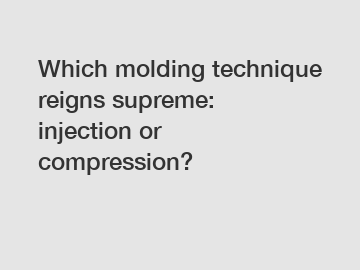Dec. 15, 2023
Packaging & Printing
Which molding technique reigns supreme: injection or compression?
When it comes to molding techniques, injection and compression are two prominent contenders in the manufacturing industry. Both methods have their advantages and are widely used for various applications. But which technique truly reigns supreme? In this article, we will delve into the pros and cons of each method to help shed light on this age-old question.
1. Injection Molding:

Injection molding is an immensely popular technique that involves injecting molten material into a mold cavity. This method offers several advantages:
- Precise and complex designs: Injection molding allows intricate and precise designs to be achieved with ease. The molds can be customized to create intricate features, such as undercuts and thin walls, which is difficult to achieve with other techniques.
- High production rates: Injection molding is known for its speed and efficiency. Multiple cavities can be incorporated into a single mold, allowing for the simultaneous production of multiple parts. This results in a high production rate, making it ideal for large-scale manufacturing.
- Versatility: Injection molding can be used with a wide range of materials, including plastics, metals, and even glass. This versatility makes it highly adaptable to various industries and applications.
However, injection molding does have some drawbacks. The initial tooling costs can be significant, particularly for complex designs. Additionally, the setup time for injection molding can be longer compared to other techniques, impacting the overall production time.
2. Compression Molding:
Contrary to injection molding, compression molding involves placing a pre-measured amount of material directly into an open mold cavity. The mold is then closed, and heat and pressure are applied to shape and cure the material. This technique also has its own set of advantages:
- Cost-effective tooling: Compression molding typically requires simpler and more cost-effective molds compared to injection molding. The molds used in compression molding are less complex, reducing the overall tooling cost.
- Less material waste: Since the material is pre-measured and placed directly into the mold, compression molding minimizes material waste. This is particularly beneficial when working with expensive or specialty materials.
- Suitable for large parts: Compression molding is particularly suitable for creating larger parts with uniform thickness. It ensures a consistent distribution of materials and can handle higher volumes, making it a preferred choice for industries like automotive and aerospace.
However, compression molding also has its limitations. It is not suitable for producing intricate designs and complex geometries as efficiently as injection molding. The cycle time for compression molding is generally longer, resulting in a slower production rate compared to injection molding.
So, which technique reigns supreme? The answer depends on various factors, including the specific requirements of the project, the desired production volume, and the complexity of the part design. While injection molding offers greater design flexibility and higher production rates, compression molding excels in cost-effectiveness and suitability for larger parts.
In conclusion, there is no clear winner between injection and compression molding. Each technique has its own unique strengths and weaknesses. Manufacturers must carefully evaluate their requirements and choose the technique that best aligns with their needs. Moreover, advancements in technology are constantly improving both methods, making them even more efficient and versatile. As the manufacturing industry continues to evolve, both injection molding and compression molding will continue to play a crucial role in meeting the demands of various industries.
For more information, please visit dispensing closure, dispensing closure, dispensing closure.
Previous: What are the top 10 custom surface protection films for purchase?
Next: What is silicone film?
If you are interested in sending in a Guest Blogger Submission,welcome to write for us!
All Comments ( 0 )